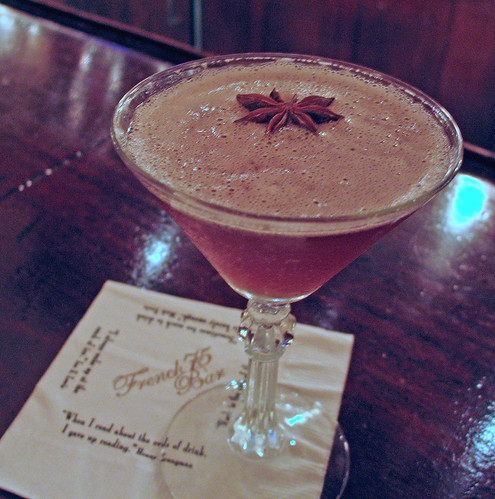The Réveillon Cocktail
Not long before Christmas 2005 I wanted to come up with an original cocktail that evoked the flavors of the holidays. “Christmas in a glass,” to purloin a phrase used by Seattle bartender Murray Stenson to describe one of this drink’s ingredients, was what I was aiming for. I wanted something more than just a one-note flavor, I wanted (as usual) a symphony of flavors. I think what we came up with (Wes helped a lot on this one) was pretty darn good.
In order to make it you’ll need to have made a batch of pimento dram, or Jamaican allspice liqueur. (This is because these days I seem pathologically incapable of concocting new cocktails unless they contain one or more very obscure ingredients.) Go ahead, it’s easy; all you need are whole allspice berries, 151 proof Demerara rum (or a mixture of Myers’ rum and Wray and Nephew Overproof Rum), brown sugar, water, a sealable jar and 40 days. Make some; you won’t regret it. “It’s the most important liqueur in the world!” declared Dr. Cocktail, with regards to the commercially made version which is completely unavailable outside Jamaica and isn’t exported.
Paul Clarke at The Cocktail Chronicles was kind and trusting enough to give my new drink a whirl and came away impressed. (Thanks!) He didn’t think I should tinker with it any more, so I didn’t. I liked it, so did Wes, and with one trustworthy taste test we decided we were pleased. It has a similar development history to the Hoskins Cocktail, in that I wanted no one ingredient to predominate and for them all work together toward the whole, and that in both cases Wes tried the first attempt, said “ehh” and suggested swapping proportions between two ingredients whereupon the bell rang, the lightbulb lit and we shrieked “Eureka!”. I wanted the holiday season in a glass, and I guess I did all right.
The acid test, of course, was when I made one for Dr. Cocktail at our 2005 holiday party. “Be critical!” I demanded. He’s opinionated and demanding and brutal regarding flavor and quality, and I knew that if he hesitated and tried to keep from making a face, it might mean a trip back to the drawing board. Instead, after one sip, he immediately said, to my great relief, “Oh, this is delightful!” and then added later, “It’s like suckin’ on Santa!” Well, that’s good enough for me.
You can use regular sweet vermouth in this, but if you use one of Carpano’s high-end vermouths like Antica Formula or Punt E Mes, as the recipe calls for, you’ll get even more wintry, spicy nuances in your drink. (Paul Clarke favors Punt E Mes, not only for its additional hint of bitterness but because it’s all he can get in the state-controlled liquor stores in Washington; the silly sods don’t carry Carpano Antica.) However, at Arnaud’s French 75 Bar in New Orleans, bartender Chris Hannah makes this drink with Dubonnet Rouge, and it’s wonderful.
As for the bitters, Angostura bitters will be easier to find, but Fee Brothers’ “Old Fashion” aromatic cocktail bitters work quite a bit better. As Dr. Cocktail once said, “Fee’s Bitters have one note, and that note is cinnamon.” That note happens to work very well for this drink. You can also use Fee’s new Whiskey Barrel Aged Bitters, which have a lovely complexity. Of course, if you happen to have any vintage Abbott’s Bitters — which haven’t been made in over 50 years but are obtainable if you’re obsessed like me and look hard enough — which are redolent with the “apple pie spices”, the flavor is beyond amazing. In a pinch, use good ol’ Angostura.
The original idea for the garnish was a cinnamon stick, but the star anise pod emerged during the photography for the drink when it was featured in the July/August 2007 issue of Imbibe magazine, which was really cool.
Now, this drink is all clear spirits so should be stirred, but Chris shakes his specifically to produce the wintry-looking froth, and the star anise pod sitting on that is perfect for the Christmas season.
Oh, and the name? Just as I was about to bestow upon this drink the well-intentioned yet supremely dopey name “Bingle Cocktail” (named, of course, for Mr. Bingle, beloved New Orleans Christmas mascot), Wes thought better of it. The name he suggested evokes Christmas, especially Christmas eve, but also the recent New Orleans spin on the old tradition that expands the feasting of la veille de Noël all season long …
The Réveillon Cocktail
2 ounces Calvados (or other apple brandy).
1/2 ounce pear eau-de-vie (clear, unsweetened pear brandy).
1/2 ounce homemade pimento dram (allspice liqueur).
1/4 ounce or Carpano Antica Formula sweet vermouth (substitute Punt e Mes) or Dubonnet Rouge (Arnaud’s version).
1 dash Fee’s Old Fashion Aromatic Bitters (or Abbott’s Bitters, if you’ve got them).
Star anise pod for garnish (or a cinnamon stick, if you don’t have star anise).Combine ingredients with cracked ice in a cocktail shaker. Stir like hell for no less than 30 seconds, and strain into a cocktail glass. Garnish with the star anise.
Serve on Christmas Eve, throughout the Twelve Days of Christmas … or whenever you want.






